Mental Health: Understanding Paranoid Schizophrenia and Treatment
VerifiedAdded on 2023/01/19
|7
|1805
|69
AI Summary
This essay discusses the signs, symptoms, and treatment of paranoid schizophrenia. It explores the importance of health promotion and recovery for individuals with this mental illness.
Contribute Materials
Your contribution can guide someone’s learning journey. Share your
documents today.

Mental Health 1
HEALTH CARE ASSIGNMENT
(By)
Class (Course)
Professor (Tutor)
School (University)
City and State
The Date
HEALTH CARE ASSIGNMENT
(By)
Class (Course)
Professor (Tutor)
School (University)
City and State
The Date
Secure Best Marks with AI Grader
Need help grading? Try our AI Grader for instant feedback on your assignments.
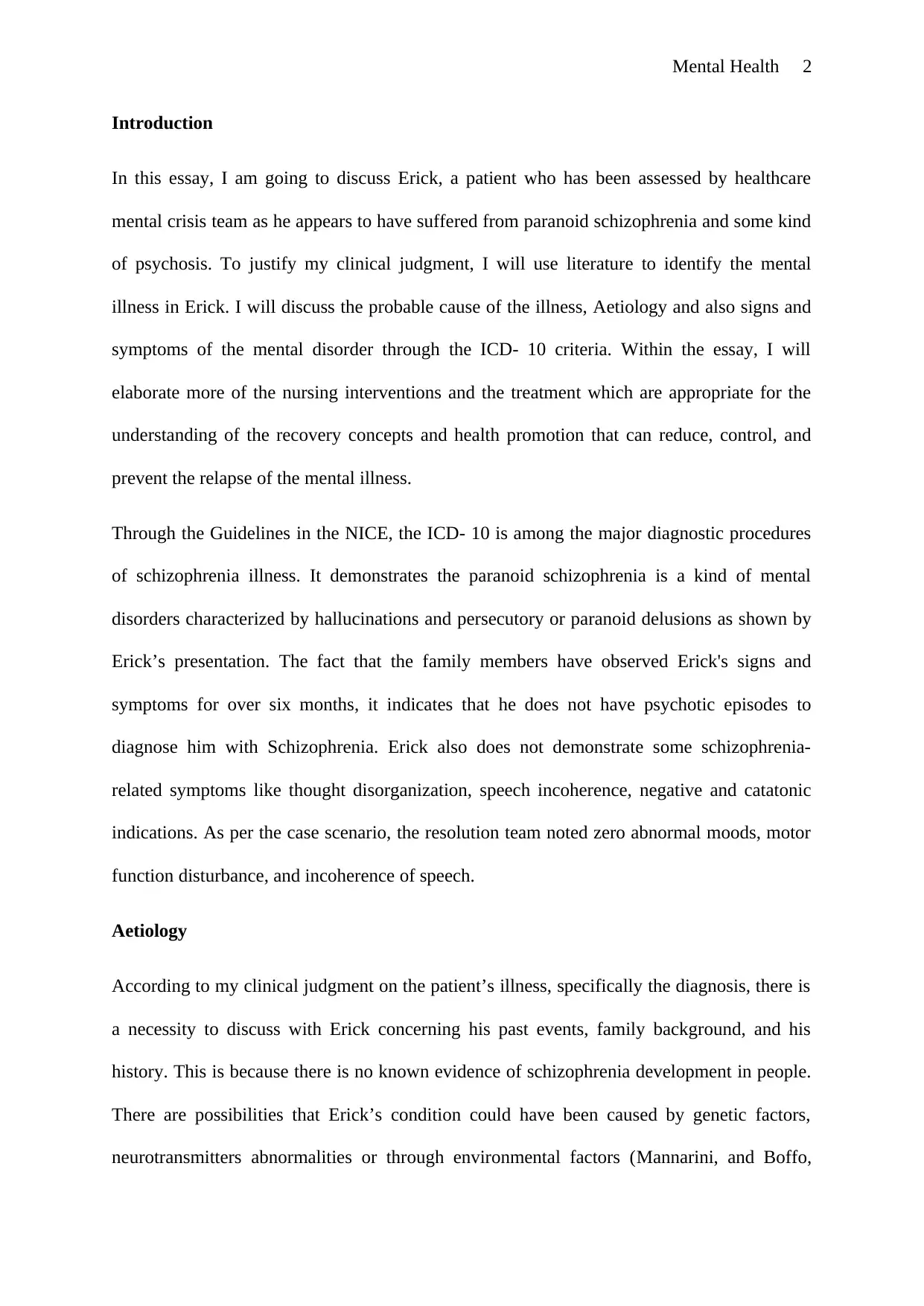
Mental Health 2
Introduction
In this essay, I am going to discuss Erick, a patient who has been assessed by healthcare
mental crisis team as he appears to have suffered from paranoid schizophrenia and some kind
of psychosis. To justify my clinical judgment, I will use literature to identify the mental
illness in Erick. I will discuss the probable cause of the illness, Aetiology and also signs and
symptoms of the mental disorder through the ICD- 10 criteria. Within the essay, I will
elaborate more of the nursing interventions and the treatment which are appropriate for the
understanding of the recovery concepts and health promotion that can reduce, control, and
prevent the relapse of the mental illness.
Through the Guidelines in the NICE, the ICD- 10 is among the major diagnostic procedures
of schizophrenia illness. It demonstrates the paranoid schizophrenia is a kind of mental
disorders characterized by hallucinations and persecutory or paranoid delusions as shown by
Erick’s presentation. The fact that the family members have observed Erick's signs and
symptoms for over six months, it indicates that he does not have psychotic episodes to
diagnose him with Schizophrenia. Erick also does not demonstrate some schizophrenia-
related symptoms like thought disorganization, speech incoherence, negative and catatonic
indications. As per the case scenario, the resolution team noted zero abnormal moods, motor
function disturbance, and incoherence of speech.
Aetiology
According to my clinical judgment on the patient’s illness, specifically the diagnosis, there is
a necessity to discuss with Erick concerning his past events, family background, and his
history. This is because there is no known evidence of schizophrenia development in people.
There are possibilities that Erick’s condition could have been caused by genetic factors,
neurotransmitters abnormalities or through environmental factors (Mannarini, and Boffo,
Introduction
In this essay, I am going to discuss Erick, a patient who has been assessed by healthcare
mental crisis team as he appears to have suffered from paranoid schizophrenia and some kind
of psychosis. To justify my clinical judgment, I will use literature to identify the mental
illness in Erick. I will discuss the probable cause of the illness, Aetiology and also signs and
symptoms of the mental disorder through the ICD- 10 criteria. Within the essay, I will
elaborate more of the nursing interventions and the treatment which are appropriate for the
understanding of the recovery concepts and health promotion that can reduce, control, and
prevent the relapse of the mental illness.
Through the Guidelines in the NICE, the ICD- 10 is among the major diagnostic procedures
of schizophrenia illness. It demonstrates the paranoid schizophrenia is a kind of mental
disorders characterized by hallucinations and persecutory or paranoid delusions as shown by
Erick’s presentation. The fact that the family members have observed Erick's signs and
symptoms for over six months, it indicates that he does not have psychotic episodes to
diagnose him with Schizophrenia. Erick also does not demonstrate some schizophrenia-
related symptoms like thought disorganization, speech incoherence, negative and catatonic
indications. As per the case scenario, the resolution team noted zero abnormal moods, motor
function disturbance, and incoherence of speech.
Aetiology
According to my clinical judgment on the patient’s illness, specifically the diagnosis, there is
a necessity to discuss with Erick concerning his past events, family background, and his
history. This is because there is no known evidence of schizophrenia development in people.
There are possibilities that Erick’s condition could have been caused by genetic factors,
neurotransmitters abnormalities or through environmental factors (Mannarini, and Boffo,
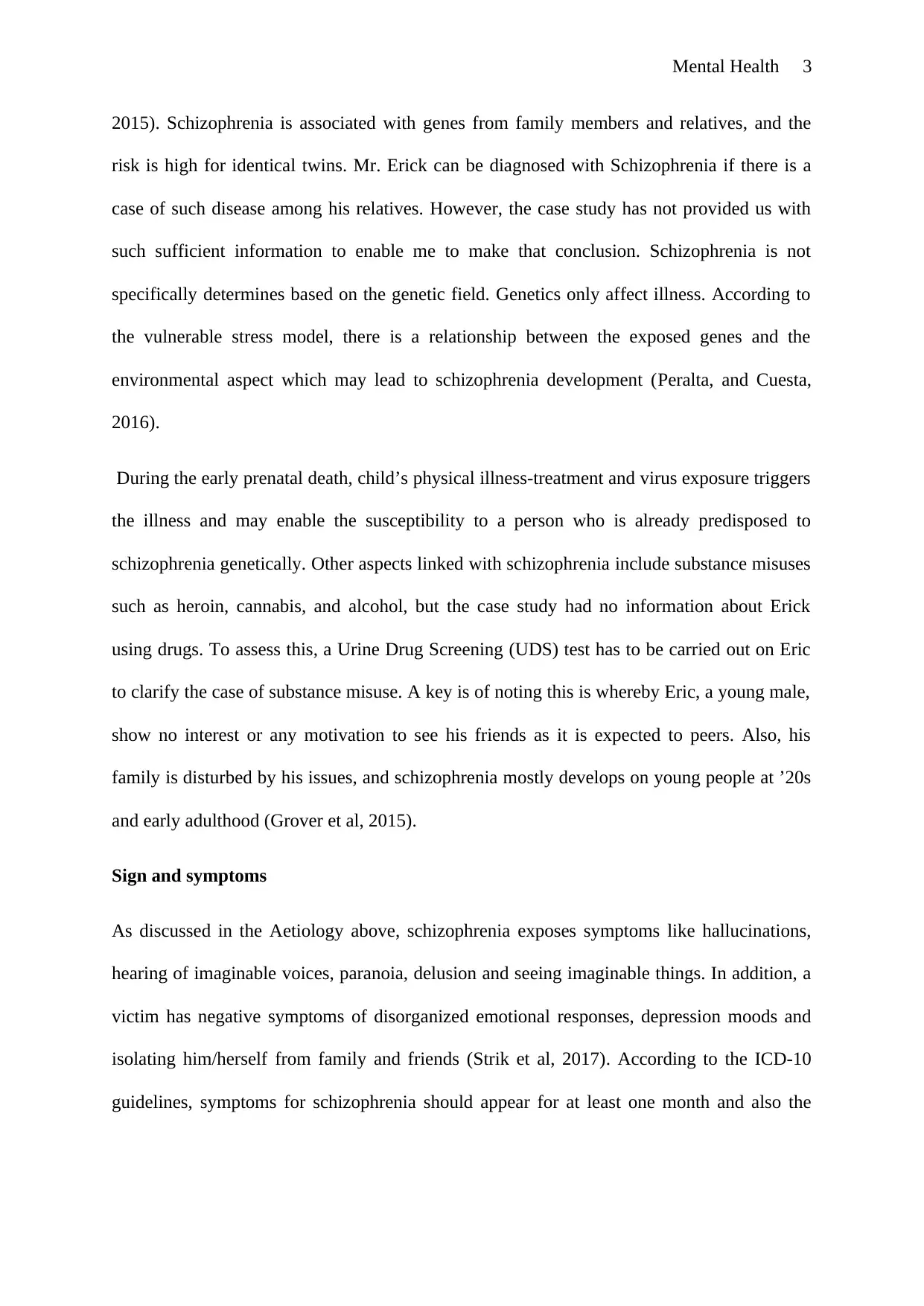
Mental Health 3
2015). Schizophrenia is associated with genes from family members and relatives, and the
risk is high for identical twins. Mr. Erick can be diagnosed with Schizophrenia if there is a
case of such disease among his relatives. However, the case study has not provided us with
such sufficient information to enable me to make that conclusion. Schizophrenia is not
specifically determines based on the genetic field. Genetics only affect illness. According to
the vulnerable stress model, there is a relationship between the exposed genes and the
environmental aspect which may lead to schizophrenia development (Peralta, and Cuesta,
2016).
During the early prenatal death, child’s physical illness-treatment and virus exposure triggers
the illness and may enable the susceptibility to a person who is already predisposed to
schizophrenia genetically. Other aspects linked with schizophrenia include substance misuses
such as heroin, cannabis, and alcohol, but the case study had no information about Erick
using drugs. To assess this, a Urine Drug Screening (UDS) test has to be carried out on Eric
to clarify the case of substance misuse. A key is of noting this is whereby Eric, a young male,
show no interest or any motivation to see his friends as it is expected to peers. Also, his
family is disturbed by his issues, and schizophrenia mostly develops on young people at ’20s
and early adulthood (Grover et al, 2015).
Sign and symptoms
As discussed in the Aetiology above, schizophrenia exposes symptoms like hallucinations,
hearing of imaginable voices, paranoia, delusion and seeing imaginable things. In addition, a
victim has negative symptoms of disorganized emotional responses, depression moods and
isolating him/herself from family and friends (Strik et al, 2017). According to the ICD-10
guidelines, symptoms for schizophrenia should appear for at least one month and also the
2015). Schizophrenia is associated with genes from family members and relatives, and the
risk is high for identical twins. Mr. Erick can be diagnosed with Schizophrenia if there is a
case of such disease among his relatives. However, the case study has not provided us with
such sufficient information to enable me to make that conclusion. Schizophrenia is not
specifically determines based on the genetic field. Genetics only affect illness. According to
the vulnerable stress model, there is a relationship between the exposed genes and the
environmental aspect which may lead to schizophrenia development (Peralta, and Cuesta,
2016).
During the early prenatal death, child’s physical illness-treatment and virus exposure triggers
the illness and may enable the susceptibility to a person who is already predisposed to
schizophrenia genetically. Other aspects linked with schizophrenia include substance misuses
such as heroin, cannabis, and alcohol, but the case study had no information about Erick
using drugs. To assess this, a Urine Drug Screening (UDS) test has to be carried out on Eric
to clarify the case of substance misuse. A key is of noting this is whereby Eric, a young male,
show no interest or any motivation to see his friends as it is expected to peers. Also, his
family is disturbed by his issues, and schizophrenia mostly develops on young people at ’20s
and early adulthood (Grover et al, 2015).
Sign and symptoms
As discussed in the Aetiology above, schizophrenia exposes symptoms like hallucinations,
hearing of imaginable voices, paranoia, delusion and seeing imaginable things. In addition, a
victim has negative symptoms of disorganized emotional responses, depression moods and
isolating him/herself from family and friends (Strik et al, 2017). According to the ICD-10
guidelines, symptoms for schizophrenia should appear for at least one month and also the
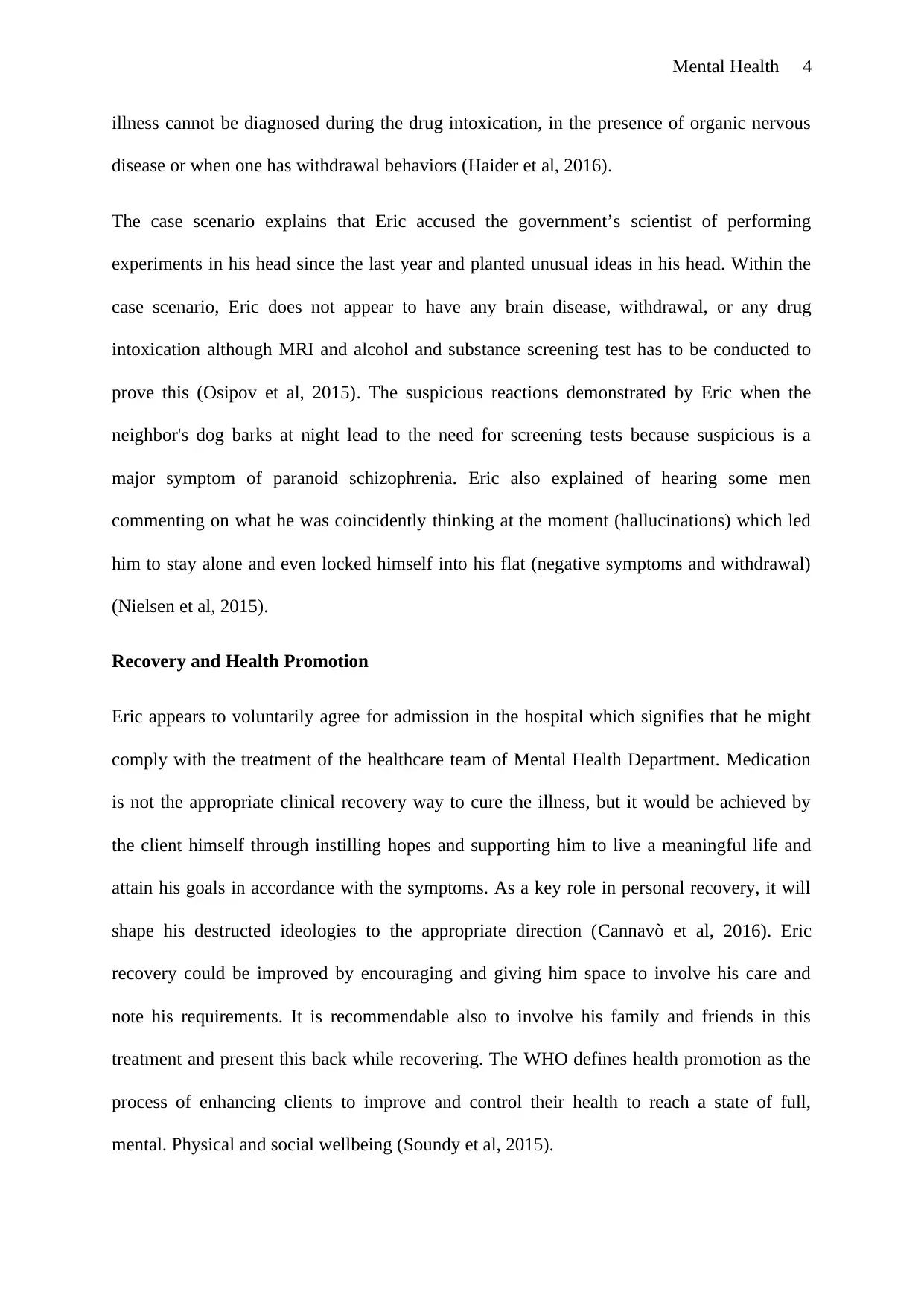
Mental Health 4
illness cannot be diagnosed during the drug intoxication, in the presence of organic nervous
disease or when one has withdrawal behaviors (Haider et al, 2016).
The case scenario explains that Eric accused the government’s scientist of performing
experiments in his head since the last year and planted unusual ideas in his head. Within the
case scenario, Eric does not appear to have any brain disease, withdrawal, or any drug
intoxication although MRI and alcohol and substance screening test has to be conducted to
prove this (Osipov et al, 2015). The suspicious reactions demonstrated by Eric when the
neighbor's dog barks at night lead to the need for screening tests because suspicious is a
major symptom of paranoid schizophrenia. Eric also explained of hearing some men
commenting on what he was coincidently thinking at the moment (hallucinations) which led
him to stay alone and even locked himself into his flat (negative symptoms and withdrawal)
(Nielsen et al, 2015).
Recovery and Health Promotion
Eric appears to voluntarily agree for admission in the hospital which signifies that he might
comply with the treatment of the healthcare team of Mental Health Department. Medication
is not the appropriate clinical recovery way to cure the illness, but it would be achieved by
the client himself through instilling hopes and supporting him to live a meaningful life and
attain his goals in accordance with the symptoms. As a key role in personal recovery, it will
shape his destructed ideologies to the appropriate direction (Cannavò et al, 2016). Eric
recovery could be improved by encouraging and giving him space to involve his care and
note his requirements. It is recommendable also to involve his family and friends in this
treatment and present this back while recovering. The WHO defines health promotion as the
process of enhancing clients to improve and control their health to reach a state of full,
mental. Physical and social wellbeing (Soundy et al, 2015).
illness cannot be diagnosed during the drug intoxication, in the presence of organic nervous
disease or when one has withdrawal behaviors (Haider et al, 2016).
The case scenario explains that Eric accused the government’s scientist of performing
experiments in his head since the last year and planted unusual ideas in his head. Within the
case scenario, Eric does not appear to have any brain disease, withdrawal, or any drug
intoxication although MRI and alcohol and substance screening test has to be conducted to
prove this (Osipov et al, 2015). The suspicious reactions demonstrated by Eric when the
neighbor's dog barks at night lead to the need for screening tests because suspicious is a
major symptom of paranoid schizophrenia. Eric also explained of hearing some men
commenting on what he was coincidently thinking at the moment (hallucinations) which led
him to stay alone and even locked himself into his flat (negative symptoms and withdrawal)
(Nielsen et al, 2015).
Recovery and Health Promotion
Eric appears to voluntarily agree for admission in the hospital which signifies that he might
comply with the treatment of the healthcare team of Mental Health Department. Medication
is not the appropriate clinical recovery way to cure the illness, but it would be achieved by
the client himself through instilling hopes and supporting him to live a meaningful life and
attain his goals in accordance with the symptoms. As a key role in personal recovery, it will
shape his destructed ideologies to the appropriate direction (Cannavò et al, 2016). Eric
recovery could be improved by encouraging and giving him space to involve his care and
note his requirements. It is recommendable also to involve his family and friends in this
treatment and present this back while recovering. The WHO defines health promotion as the
process of enhancing clients to improve and control their health to reach a state of full,
mental. Physical and social wellbeing (Soundy et al, 2015).
Secure Best Marks with AI Grader
Need help grading? Try our AI Grader for instant feedback on your assignments.
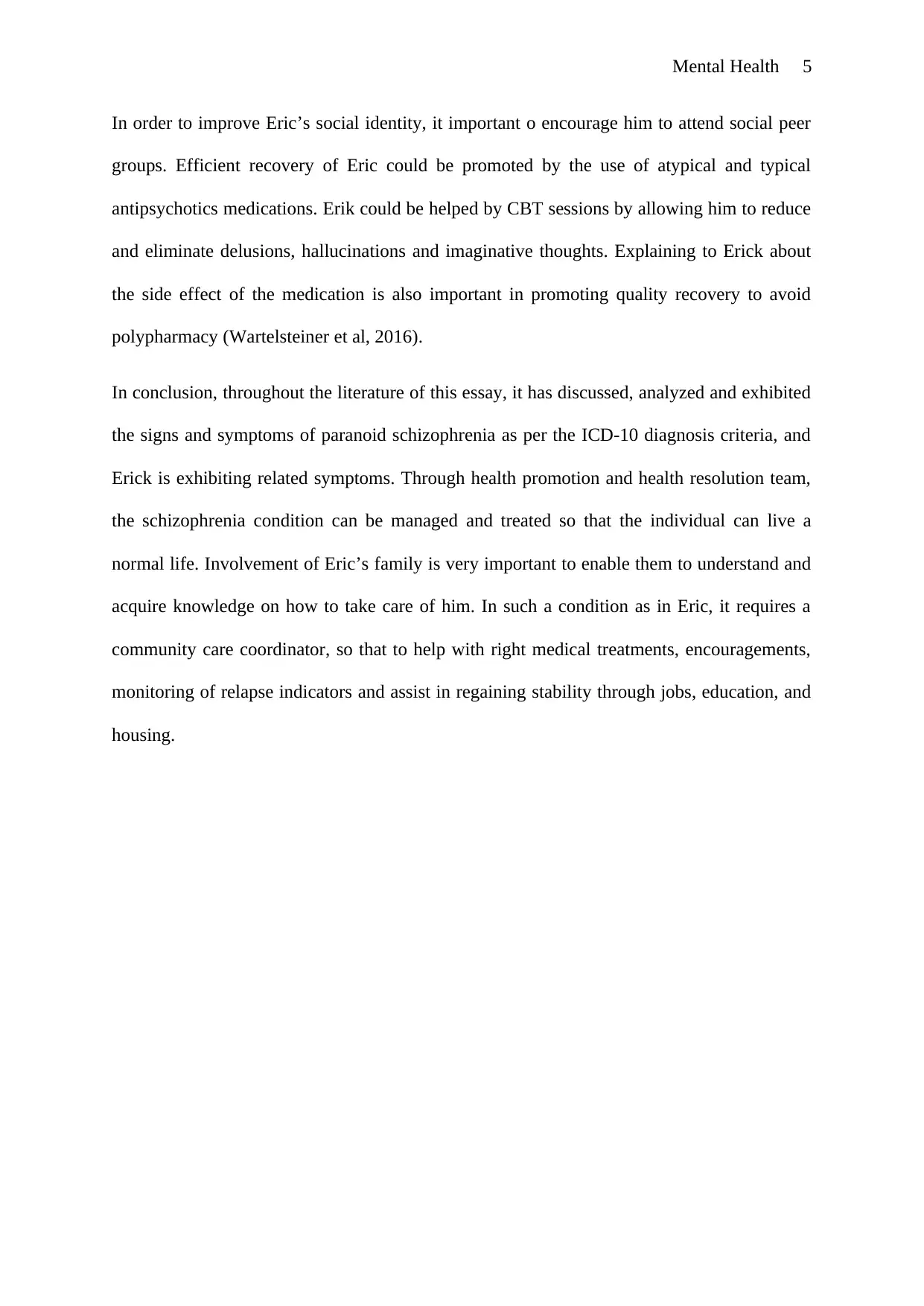
Mental Health 5
In order to improve Eric’s social identity, it important o encourage him to attend social peer
groups. Efficient recovery of Eric could be promoted by the use of atypical and typical
antipsychotics medications. Erik could be helped by CBT sessions by allowing him to reduce
and eliminate delusions, hallucinations and imaginative thoughts. Explaining to Erick about
the side effect of the medication is also important in promoting quality recovery to avoid
polypharmacy (Wartelsteiner et al, 2016).
In conclusion, throughout the literature of this essay, it has discussed, analyzed and exhibited
the signs and symptoms of paranoid schizophrenia as per the ICD-10 diagnosis criteria, and
Erick is exhibiting related symptoms. Through health promotion and health resolution team,
the schizophrenia condition can be managed and treated so that the individual can live a
normal life. Involvement of Eric’s family is very important to enable them to understand and
acquire knowledge on how to take care of him. In such a condition as in Eric, it requires a
community care coordinator, so that to help with right medical treatments, encouragements,
monitoring of relapse indicators and assist in regaining stability through jobs, education, and
housing.
In order to improve Eric’s social identity, it important o encourage him to attend social peer
groups. Efficient recovery of Eric could be promoted by the use of atypical and typical
antipsychotics medications. Erik could be helped by CBT sessions by allowing him to reduce
and eliminate delusions, hallucinations and imaginative thoughts. Explaining to Erick about
the side effect of the medication is also important in promoting quality recovery to avoid
polypharmacy (Wartelsteiner et al, 2016).
In conclusion, throughout the literature of this essay, it has discussed, analyzed and exhibited
the signs and symptoms of paranoid schizophrenia as per the ICD-10 diagnosis criteria, and
Erick is exhibiting related symptoms. Through health promotion and health resolution team,
the schizophrenia condition can be managed and treated so that the individual can live a
normal life. Involvement of Eric’s family is very important to enable them to understand and
acquire knowledge on how to take care of him. In such a condition as in Eric, it requires a
community care coordinator, so that to help with right medical treatments, encouragements,
monitoring of relapse indicators and assist in regaining stability through jobs, education, and
housing.

Mental Health 6
Reference
Cannavò, D., Minutolo, G., Battaglia, E. and Aguglia, E., 2016. Insight and recovery in
schizophrenic patients. International journal of psychiatry in clinical practice, 20(2), pp.83-
90.
Grover, S., Chakrabarti, S., Ghormode, D., Agarwal, M., Sharma, A. and Avasthi, A., 2015.
Catatonia in inpatients with psychiatric disorders: a comparison of schizophrenia and mood
disorders. Psychiatry research, 229(3), pp.919-925.
Haider, A.S., Alam, M., Adetutu, E., Thakur, R., Gottlich, C., DeBacker, D.L. and Marks, L.,
2016. Autoimmune Schizophrenia? Psychiatric Manifestations of Hashimoto's Encephalitis.
Cureus, 8(7).
Mannarini, S. and Boffo, M., 2015. Anxiety, bulimia, drug and alcohol addiction, depression,
and schizophrenia: what do you think about their aetiology, dangerousness, social distance,
and treatment? A latent class analysis approach. Social psychiatry and psychiatric
epidemiology, 50(1), pp.27-37.
Nielsen, G., Stone, J., Matthews, A., Brown, M., Sparkes, C., Farmer, R., Masterton, L.,
Duncan, L., Winters, A., Daniell, L. and Lumsden, C., 2015. Physiotherapy for functional
motor disorders: a consensus recommendation. J Neurol Neurosurg Psychiatry, 86(10),
pp.1113-1119.
Osipov, M., Behzadi, Y., Kane, J.M., Petrides, G. and Clifford, G.D., 2015. Objective
identification and analysis of physiological and behavioral signs of schizophrenia. Journal of
Mental Health, 24(5), pp.276-282.
Peralta, V. and Cuesta, M.J., 2016. Delusional disorder and schizophrenia: a comparative
study across multiple domains. Psychological medicine, 46(13), pp.2829-2839.
Soundy, A., Stubbs, B., Roskell, C., Williams, S.E., Fox, A. and Vancampfort, D., 2015.
Identifying the facilitators and processes which influence recovery in individuals with
Reference
Cannavò, D., Minutolo, G., Battaglia, E. and Aguglia, E., 2016. Insight and recovery in
schizophrenic patients. International journal of psychiatry in clinical practice, 20(2), pp.83-
90.
Grover, S., Chakrabarti, S., Ghormode, D., Agarwal, M., Sharma, A. and Avasthi, A., 2015.
Catatonia in inpatients with psychiatric disorders: a comparison of schizophrenia and mood
disorders. Psychiatry research, 229(3), pp.919-925.
Haider, A.S., Alam, M., Adetutu, E., Thakur, R., Gottlich, C., DeBacker, D.L. and Marks, L.,
2016. Autoimmune Schizophrenia? Psychiatric Manifestations of Hashimoto's Encephalitis.
Cureus, 8(7).
Mannarini, S. and Boffo, M., 2015. Anxiety, bulimia, drug and alcohol addiction, depression,
and schizophrenia: what do you think about their aetiology, dangerousness, social distance,
and treatment? A latent class analysis approach. Social psychiatry and psychiatric
epidemiology, 50(1), pp.27-37.
Nielsen, G., Stone, J., Matthews, A., Brown, M., Sparkes, C., Farmer, R., Masterton, L.,
Duncan, L., Winters, A., Daniell, L. and Lumsden, C., 2015. Physiotherapy for functional
motor disorders: a consensus recommendation. J Neurol Neurosurg Psychiatry, 86(10),
pp.1113-1119.
Osipov, M., Behzadi, Y., Kane, J.M., Petrides, G. and Clifford, G.D., 2015. Objective
identification and analysis of physiological and behavioral signs of schizophrenia. Journal of
Mental Health, 24(5), pp.276-282.
Peralta, V. and Cuesta, M.J., 2016. Delusional disorder and schizophrenia: a comparative
study across multiple domains. Psychological medicine, 46(13), pp.2829-2839.
Soundy, A., Stubbs, B., Roskell, C., Williams, S.E., Fox, A. and Vancampfort, D., 2015.
Identifying the facilitators and processes which influence recovery in individuals with
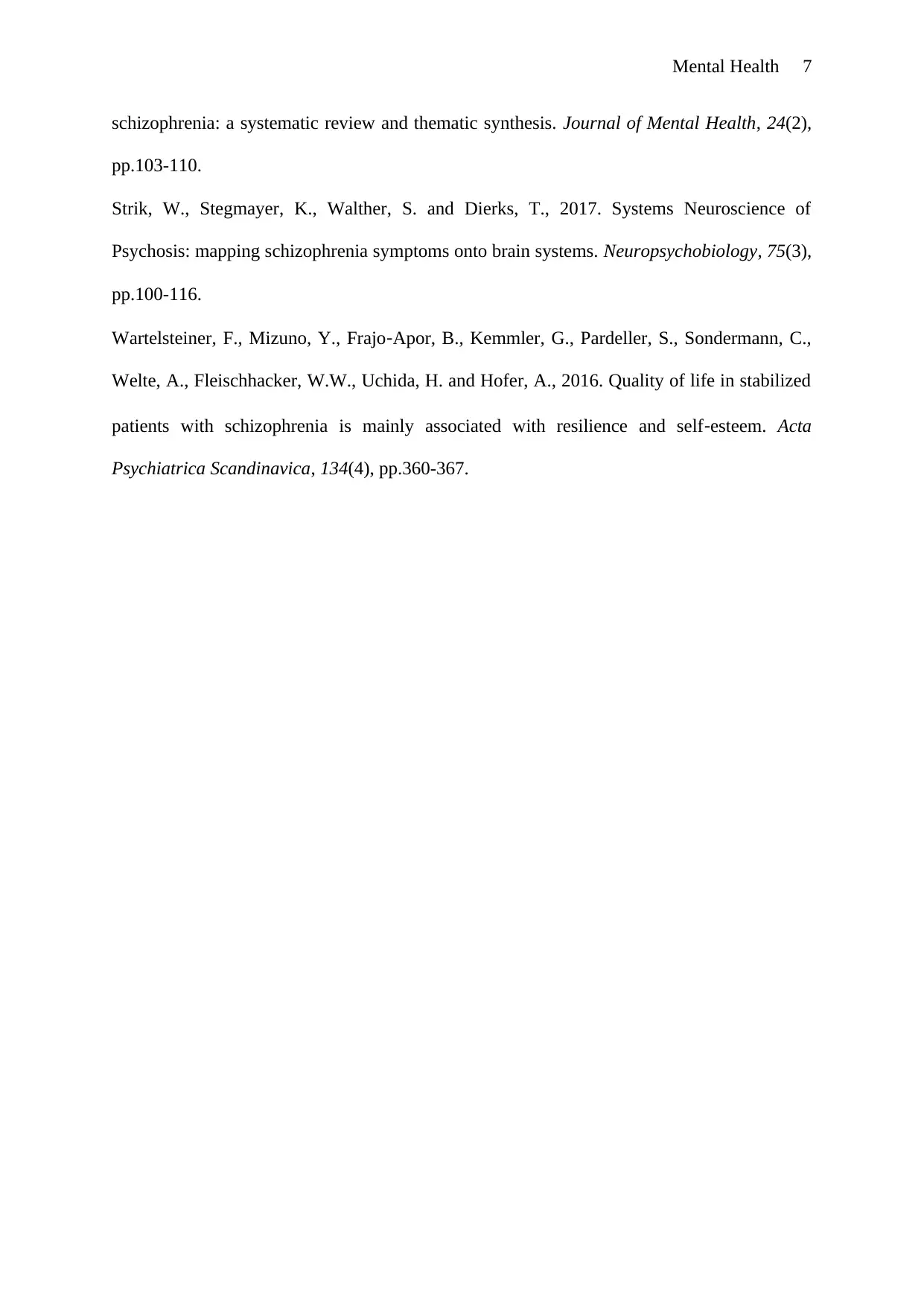
Mental Health 7
schizophrenia: a systematic review and thematic synthesis. Journal of Mental Health, 24(2),
pp.103-110.
Strik, W., Stegmayer, K., Walther, S. and Dierks, T., 2017. Systems Neuroscience of
Psychosis: mapping schizophrenia symptoms onto brain systems. Neuropsychobiology, 75(3),
pp.100-116.
Wartelsteiner, F., Mizuno, Y., Frajo‐Apor, B., Kemmler, G., Pardeller, S., Sondermann, C.,
Welte, A., Fleischhacker, W.W., Uchida, H. and Hofer, A., 2016. Quality of life in stabilized
patients with schizophrenia is mainly associated with resilience and self‐esteem. Acta
Psychiatrica Scandinavica, 134(4), pp.360-367.
schizophrenia: a systematic review and thematic synthesis. Journal of Mental Health, 24(2),
pp.103-110.
Strik, W., Stegmayer, K., Walther, S. and Dierks, T., 2017. Systems Neuroscience of
Psychosis: mapping schizophrenia symptoms onto brain systems. Neuropsychobiology, 75(3),
pp.100-116.
Wartelsteiner, F., Mizuno, Y., Frajo‐Apor, B., Kemmler, G., Pardeller, S., Sondermann, C.,
Welte, A., Fleischhacker, W.W., Uchida, H. and Hofer, A., 2016. Quality of life in stabilized
patients with schizophrenia is mainly associated with resilience and self‐esteem. Acta
Psychiatrica Scandinavica, 134(4), pp.360-367.
1 out of 7
Related Documents
Your All-in-One AI-Powered Toolkit for Academic Success.
+13062052269
info@desklib.com
Available 24*7 on WhatsApp / Email
![[object Object]](/_next/static/media/star-bottom.7253800d.svg)
Unlock your academic potential
© 2024 | Zucol Services PVT LTD | All rights reserved.





